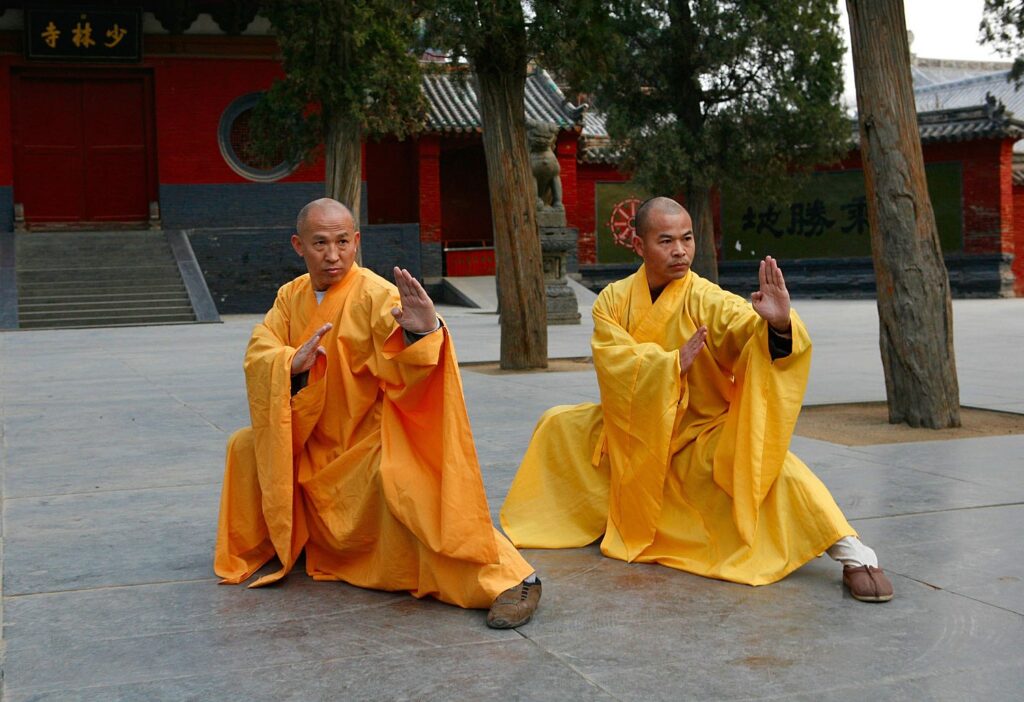- Gentle graceful movements that when applied can destroy
“All martial arts under heaven originated from Shaolin.”
Martial arts existed before Shaolin, but Shaolin Kung Fu has influenced countless martial traditions throughout Asia. Skilled warriors came to study under the dhyana master Buddhabhadra in the first Shaolin temple. Application of Chan Buddhist philosophy to the existing fighting skills of Buddhabhadra’s students gave birth to Shaolin Kung-Fu.
“Shaolin is Chan, not Quan.”
Luohanquan is the Arhat fist. Arhat is to understand nature and reach enlightenment. Quan is the martial study of the Shaolin monks. However, Quan is a means for one to understand Chan. It is through this martial discipline that warrior-monks come to understand Buddhism. Exercises are designed to focus the body as well as the mind under these ideals.
During the Qing dynasty, Shaolin monks identified one hundred styles of Kung Fu. From these one hundred styles, eighteen were chosen as the most representative. To this day, multiple different disciplines of Kung Fu are taught at Shaolin temples around the world. They are blended together to form variations unique to the teachers and students. Luohan Shaolin Kung Fu is not a single style, but rather intended to represent an older iteration of Shaolin Kung Fu. It does not focus so much on the Imitative styles, such as Dragon, Mantis, or Tiger, but the fundamental ideals of the Luohanquan styles.
Within a century of the temple’s founding, the eighteen methods of Luohan began to emerge. These would be the founding principles of Shaolin Kung Fu. Records of monks defending the Shaolin temple in 610 AD along with the later involvement in the Battle of Hulao (621 AD) help to confirm this timeline. With powerful, sometimes unpredictable strikes, the Shaolin monks are renowned for their athleticism. They are also known for the rigorous, almost brutal, training standards which help to sharpen one’s discipline, focus the mind, and strengthen the body.
Associated Weapons: Knives (and other small blades, or pointed weapons), Monk’s Spade, Spear, Staff, Swords, Three Section Staff, Whip (and other flexible weapons)
Shaolin Kung Fu is often associated with a deep crouching style, arms kept tight or slightly extended with hands protruded, and a front leg either extended or chambered. Strikes extend the body with explosive power before recoiling back to a neutral stance.
Author’s Note: All builds presented in this series should not be taken as the only way to interpret a given style. Players and GMs are encouraged to treat these as a framework to build their own character’s style.
Style Progression – Very Slow
Fighting Style: Luohan Shaolin Kung Fu
- Parent Attribute: Mental or Expression
- Primary Role: Defense
- First Secondary Role: Offense
Common Specialties:
- Bypass Armor
- Explosive Power (Explosive Willpower Feature)
- Power Strike
- Second Wind (The character must take more Damage than their Starting Willpower, then use the Flesh Wound Willpower Feature,.)
Common Combos:
- Counter and Assess: Active Defense – Bypass Armor
- Counter Strike: Active Defense – Attack
- Know Your Enemy: Active Defense – Bypass Armor – Trip – Set Up
- Meridian Strike: Stagger – Power Strike
Key Talents:
- Acrobatics
- Concentration
- Etiquette
- Fitness
- Perception
- Perseverance
- Religion
- Buddhism
Additional Boons
- Advantaged TY
- Languages: Cantonese, Mandarin, Malay, Tamil TY
- Acrobatics Supports Offense MA
- Perseverance Supports Explosive Power MA
- Religion Supports Defense MA
- Tricky TY
Super Style – Luohan Shaolin Kung Fu
There are few styles that would be considered to require the same level of discipline and commitment as to master Luohan Shaolin Kung Fu. It is a contradiction within itself, both multifaceted and focused, requiring multiple areas of specialization to fully realize the depth of the discipline.
Example (Classic Power Level)
Luohan Shaolin Kung Fu 12
- Parent Attribute: Mental
- Primary Role: Defense
Armor MA
Defends Against: MA
Passive Defense TY
Unique Drawback: Activation Required
Secondary Role: Offense (Full Role) MA2
Secondary Role: Support: Strength, Dexterity MA2
Locked Power: Armor and Painful linked to Passive Defense
(S) Bypass Armor 7
(S) Counter and Assess 4
(S) Know Your Enemy 7
(S) Pick One:
- Explosive Power 7
- Second Wind 7
The warrior-monk has strengthened their body, honed their reflexes, and turned themselves into something others might see as superhuman. Body hardening is an extension of the Shaolin fighter’s mental discipline protecting them from any attack. Nevertheless, even after years of training, the Luohan Shaolin Kung Fu aspirant has decades to continue along their journey.
Cost 1 Power + 12 Selections + 11 AP
Boons
Combo: Counter and Assess: Active Defense – Bypass Armor TY
Combo: Know Your Enemy: Active Defense – Bypass Armor – Trip – Set Up TY
Languages: Cantonese, Mandarin, Malay, Tamil TY
Acrobatics Supports Offense MA
Perseverance Supports Explosive Power MA
Religion Supports Defense MA
Cost 1 + 1 + 1 + 2 + 2 + 2 = 9 AP
Use In Conflict
The Luohan Shaolin Kung Fu martial artist has a number of tools in their arsenal. As such, they must be careful how these tools are applied. Taking the time to assess your foes opens them up to powerful strikes. Depending on if the martial artist focuses on Explosive Power or Second Wind will greatly influence if they hold back countering foes repeatedly before unleashing their full power, or if they trade more strategically as they expend their Willpower for explosive attacks.Ultimately, the martial artist will want to master both these key philosophies.

